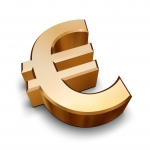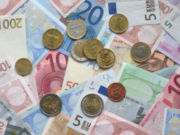Euro��������(0)�༭����
The euro (�) is the official currency of 16 of the 27 member states
of the European Union (EU). The states, known collectively as the Eurozone, are Austria, Belgium, Cyprus, Finland, France, Germany, Greece, Ireland, Italy, Luxembourg, Malta, the Netherlands, Portugal, Slovakia, Slovenia, and Spain. The currency is also used in a further five European countries, with and without formal agreements and is consequently used daily by some 327 million Europeans. Over 175 million people worldwide use currencies which are pegged to the euro, including more than 150 million people in Africa.
The euro is the second largest reserve currency and the second most traded currency in the world after the U.S. dollar. As of November 2008, with more than �751 billion in circulation, the euro is the currency with the highest combined value of cash in circulation in the world, having surpassed the U.S. dollar. Based on IMF estimates of 2008 GDP and purchasing power parity among the various currencies, the Eurozone is the second largest economy in the world.
The name euro was officially adopted on 16 December 1995. The euro was introduced to world financial markets as an accounting currency on 1 January 1999, replacing the former European Currency Unit (ECU) at a ratio of 1:1. Euro coins and banknotes entered circulation on 1 January 2002.
Coins and banknotes
The euro is divided into 100 cents (sometimes referred to as euro-cents, especially when distinguishing them from other currencies). In official contexts the plural forms of euro and cent are spelled without the s, notwithstanding normal English usage. Otherwise, normal English plurals are recommended and used. All circulating coins have a common side showing the denomination or value, and a map in the background. For the denominations except the 1-, 2- and 5-cent coins that map only showed the 15 member states which were members when the euro was introduced. Beginning in 2007 or 2008 (depending on the country) the old map is being replaced by a map of Europe also showing countries outside the Union like Norway. The 1-, 2- and 5-cent coins, however, keep their old design, showing a geographical map of Europe with the 15 member states of 2002 raised somewhat above the rest of the map. All common sides were designed by Luc Luycx. The coins also have a national side showing an image specifically chosen by the country that issued the coin. Euro coins from any member state may be freely used in any nation which has adopted the euro.
The coins are issued in �2, �1, 50-cent, 20-cent, 10-cent, 5-cent, 2-cent, and 1-cent denominations. In order to avoid the use of the two smallest coins, some cash transactions are rounded to the nearest five cents in the Netherlands (by voluntary agreement) and in Finland (by law).
Commemorative coins with �2 face value have been issued with changes to the design of the national side of the coin. These include both commonly issued coins, such as the �2 commemorative coin for the fiftieth anniversary of the signing of the Treaty of Rome, and nationally issued coins, such as the coin to commemorate the 2004 Summer Olympics issued by Greece. These coins are legal tender throughout the Eurozone. Collector��s coins with various other denominations have been issued as well, but these are not intended for general circulation, and they are legal tender only in the member state that issued them.
The design for euro banknotes have common designs on both sides. The design was created by Robert Kalina. Notes are issued in �500, �200, �100, �50, �20, �10, �5. Each banknote has its own colour and is dedicated to an artistic period of European architecture. The front of the note features windows or gateways while the back has bridges. While the designs are supposed to be devoid of any identifiable characteristics, the initial designs by Robert Kalina were of specific bridges, including the Rialto and the Pont de Neuilly, and were subsequently rendered more generic; the final designs still bear very close similarities to their specific prototypes; thus they are not truly generic. Some of the highest denominations such as the �500 are not issued in all countries, though they remain legal tender throughout the Eurozone.
Currency sign
A special euro currency sign (�) was designed after a public survey had narrowed the original ten proposals down to two. The European Commission then chose the design created by the Belgian Alain Billiet. The official story of the design history of the euro sign is disputed by Arthur Eisenmenger, a former chief graphic designer for the EEC, who claims to have created it as a generic symbol of Europe.
The European Commission also specified a euro logo with exact proportions and foreground/background colour tones. While the Commission intended the logo to be a prescribed glyph shape, font designers made it clear that they intended to design their own variants instead. Typewriters lacking the euro sign can create it by typing a capital 'C', backspacing and overstriking it with the equal ('=') sign. Placement of the currency sign relative to the numeric amount varies from nation to nation, and there is no official recommendation on the issue.
Introduction of the euro
The euro was established by the provisions in the 1992 Maastricht Treaty. In order to participate in the currency, member states are meant to meet strict criteria such as a budget deficit of less than three per cent of their GDP, a debt ratio of less than sixty per cent of GDP, low inflation, and interest rates close to the EU average. In the Maastricht Treaty, the United Kingdom and Denmark were granted exemptions per their request from moving to the stage of monetary union which would result in the introduction of the euro.
Economists who helped create or contributed to the euro include Robert Mundell, Wim Duisenberg, Robert Tollison, Neil Dowling, Fred Arditti and Tommaso Padoa-Schioppa. (For macro-economic theory, see below.) The name euro was devised on 4 August 1995 by Germain Pirlot, a Belgian esperantist and ex-teacher of French and history, and officially adopted in Madrid on 16 December 1995.
Due to differences in national conventions for rounding and significant digits, all conversion between the national currencies had to be carried out using the process of triangulation via the euro. The definitive values in euro of these subdivisions (which represent the exchange rates at which the currency entered the euro) are shown at right.
The rates were determined by the Council of the European Union, based on a recommendation from the European Commission based on the market rates on 31 December 1998. They were set so that one European Currency Unit (ECU) would equal one euro. The European Currency Unit was an accounting unit used by the EU, based on the currencies of the member states; it was not a currency in its own right. They could not be set earlier, because the ECU depended on the closing exchange rate of the non-euro currencies (principally the pound sterling) that day.
The procedure used to fix the irrevocable conversion rate between the drachma and the euro was different, since the euro by then was already two years old. While the conversion rates for the initial eleven currencies were determined only hours before the euro was introduced, the conversion rate for the Greek drachma was fixed several months beforehand.
The currency was introduced in non-physical form (travellers' cheques, electronic transfers, banking, etc.) at midnight on 1 January 1999, when the national currencies of participating countries (the Eurozone) ceased to exist independently. Their exchange rates were locked at fixed rates against each other, effectively making them mere non-decimal subdivisions of the euro. The euro thus became the successor to the European Currency Unit (ECU). The notes and coins for the old currencies, however, continued to be used as legal tender until new euro notes and coins were introduced on 1 January 2002.
The changeover period during which the former currencies' notes and coins were exchanged for those of the euro lasted about two months, until 28 February 2002. The official date on which the national currencies ceased to be legal tender varied from member state to member state. The earliest date was in Germany where the mark officially ceased to be legal tender on 31 December 2001, though the exchange period lasted for two months more. Even after the old currencies ceased to be legal tender, they continued to be accepted by national central banks for periods ranging from several years to forever (the latter in Austria, Germany, Ireland, and Spain). The earliest coins to become non-convertible were the Portuguese escudos, which ceased to have monetary value after 31 December 2002, although banknotes remain exchangeable until 2022.
ŷԪ���������EUR����ŷ����ʮ�������ҵĻ��ҡ���ʮ���������ǣ��µ���������ʱ���������������¹���ϣ�������������������¬ɭ������������������˹�������Ǻ������������Ǻϳ�ΪŷԪ����Eurozone����ŷԪ�����һ���Ϊŷ�ޡ�
��ʷ
ŷԪ���������۹�����ŷ���Ҹĸ���Ϊ�ش�Ľ����ŷԪ������ʹŷ��һ�г��������ƣ�ŷԪ�����Ҽ�����ó���ӷ��㣬���Ҹ���ŷ��һ�廯���̵���Ҫ��ɲ��֡�
����Ħ�ɸ硢ʥ����ŵ����ٸԲ�����ŷ�˹��ң���������������ǰʹ�÷������ɻ��������������Ϊ���ң�����Ҳʹ��ŷԪ����Ȩ���������������Լ���ŷԪӲ�ҡ�һЩ��ŷ�˹��Һ͵����������ɽ�������ֺͰ�������Ҳʹ��ŷԪ��Ϊ֧�����ߡ�
ŷԪ��ŷ���������У�European Central Bank��ECB����ŷԪ�����ҵ�����������ɵ�ŷ����������ϵͳ��European System of Central Banks��ESCB������������ܲ������ڵ¹������˸���ŷ�����������ж����ƶ��������ߵ�Ȩ����ŷԪ�����ҵ��������в���ŷԪֽ�Һ�ŷԪӲ�ҵ�ӡˢ�������뷢�У�������ŷԪ��֧��ϵͳ��������
�ص�
���е�ŷԪӲ�ҵ����涼����ͬ�ģ�����Ӳ�ҵ���ֵ����Ϊ����ͬ�棨common side��������Ӳ�ұ����ͼ�������ɷ��й�������Ƶģ�national side�������������ƹ��ҳ���ʹ�����Ǿ�����ͷ�������Ĺ���ͨ�������ǹ��ҵ����������в�ͬ��Ӳ�Ҷ����������е���ʹ�ã�������������������ͷ���Ӳ���ڳ������������������ʹ��ŷԪ�Ĺ���Ҳ�Ƿ������ҡ�ŷԪӲ��һ����8�֣�2ŷԪ��1ŷԪ��50ŷ�֡�20ŷ�֡�10ŷ�֡�5ŷ�֡�2ŷ�ֺ�1ŷ�֡���Ȼ1ŷ�ֺ�2ŷ�ֵ�Ӳ��һ�㲻�ڷ����ͺ���ʹ�ã�����Ȼ�Ƿ������ҡ�
ÿ������ŷԪֽ�ҵ�����ڸ�������һ���ġ�ŷԪֽ��һ����7�֣�500ŷԪ��200ŷԪ��100ŷԪ��50ŷԪ��20ŷԪ��10ŷԪ��5ŷԪ�����ܴ�����ֽ����ijЩ���Ҳ������У�����Ȼ�Ƿ������ҡ�
��ŷ�Զ�ʵʱ����ϵͳ��Trans-European Automated Real-Time Gross Settlement Express Transfer System��TARGET����һ����ŷԪ������ǰ���Ѿ�������ŷ��Χ�ڴ�������ϵͳ������С��֧����һ������ǣ���ŷԪ��֮�ڵ�ת����Ϊ����ת�ˣ�ŷԪ�������ÿ�֧����ATMȡ��ķ�������ڷ�����ͬ��Ʊ��֧��������֧Ʊ�ȣ�Ҳ�������ͬ��
ת��
ŷԪ����1992��Ϊ����ŷ���û���ͬ�ˣ�EMU��������˹�������ǩ���ġ�ŷ��������Լ����ȷ���ġ���Ա����Ҫ����һϵ���ϸ�ı�������Ԥ����ֲ��ó�������������ֵ��3������ծ�ʲ���������������ֵ60����ͨ�������ʺ����ʽӽ�ŷ�˹��ҵ�ƽ��ˮƽ��
���ڸ����������λϰ�߲�ͬ���������Ҽ��ת������ͨ��ŷԪ���С�ŷԪ��ԭ�л��ҵĹ̶�ת���������£�
��Щת����������ŷ��������ŷ��ίԱ��Ľ��飬��1998��12��31�յ��г�����Ϊ������ȷ���ģ�1ŷ���ҵ�λ����1ŷԪ����Ϊŷ���ҵ�λ�ļ�ֵȡ���ڷ�ŷԪ���ң���Ҫ��Ӣ�����ĵ������̼ۣ����Ըû���û�и���ȷ����
ʹ��ŷԪ�Ĺ���
Ŀǰ�ٷ�ʹ��ŷԪ�Ĺ����У��µ���������ʱ���������������¹���ϣ�������������������¬ɭ������������������˹�������Ǻ���������ijЩŷԪ�����ҵĺ������������編�������ǡ���������ʥƤ�������ܿ�¡Ⱥ����������˵ȵ���Ҳʹ��ŷԪ��2009��01��01��˹�工����ʽ����ŷԪ������Ϊʹ��ŷԪ�ĵڣ�����ŷ�˹��ҡ�
Ħ�ɸ���ǰʹ�÷������ɡ�ʥ����ŵ����ٸ���ǰʹ��������������������ѱ�ŷԪ������������Ǻ�ŷ��֮���Э�飬����Ҳ���Դ���ŷ������ŷԪӲ�ҡ�
��������ǰʹ�÷������ɺ�����������������ɽ����������ǰʹ�õ¹����ˣ��������Ǻ�ŷ��֮��û���κη����ϵ�Э����������ʹ��ŷԪ������Ŀǰ����Ҳ��ŷԪ��Ϊ��ʵ�ʵġ����ҡ���2004��10�£���������ʼ��ŷ��Э�̹���������������Ħ�ɸ硢ʥ����ŵ����ٸ�һ������ŷԪӲ�ҵ�Э�顣
ŷԪ��֮���ŷ�˹���
���
�������û����Ӣ���͵���������ʽѡ���˳����úͻ���ͬ�ˣ�EMU ����������ϱ�����ij��ʱ��ת��ΪŷԪ��������2003��9��14�������еľ��Ƿ�ͬ��������ŷԪ����ȫ���У��������乫��Ͷ�˷���Ʊ������������Ϊ�̵���ڶ�������������ŷԪ�����ҡ�
Ӣ��
Ӣ����ŷԪ����������ΪŷԪ�������γ�һ��ͳһ��ŷ��������ĵ��ʯ������Ӣ�����������ƶ����ʶ�Ӣ���������к��ġ��෴�Ĺ۵���Ϊ����Ȼ��ŷ���ҵij���ռӢ�������ܶ��60�����ϣ��������ʷ��նԵ�һ�г��������ġ�Ӣ����������Ҫ������ŵ�ھ�������ŷԪ��֮ǰ����ȫ���������������һֱ��ʾ���˷��Լ���ŷԪ����
����
������2002������˹����Ƿ����ŷԪ����ȫ����������ѡ���˲�����ŷԪ��������䲻ͬ���ǣ�������ʵĻ����Ƕ�סŷԪ�ģ��1��DKr7.46038��2.25����
ŷԪ��ֽ�Һ�Ӳ�����
����ŷԪֽ�ҵ���ֵ����7�֣��ֱ�Ϊ5ŷԪ��10ŷԪ��20ŷԪ��50ŷԪ��100ŷԪ��200ŷԪ��500ŷԪ��1ŷԪ=100�֡�
ŷԪӲ�ҵ���ֵ����8�֣��ֱ�Ϊ1�֡�2�֡�5�֡�10�֡�20�֡�50�֡�1ŷԪ��2ŷԪ��
ŷԪͼ����˭��Ƶĺ���
����ŷԪͼ������ŷ���Ҿֹ�����������1996��12��13������ȷ���ġ��µ���ֽ����Ƽ����ء������ɵķ��������á����տ����ɷ�����Ʊ��ֵԽ��ֽ�����Խ����ֽ������ͼ������Ҫ��ɲ������źʹ��������ź�����̹�Ͼ���12����Χ��һ��ԲȦ������ŷ�˸�����г��������ŷ�ޡ�ֽ�ҵķ�����������ͼ��������ŷ������ϵ���ܡ������š���������ͼ���ֱ����ŷ��ʱ�ڵĽ������ֵ��С��������Ϊ�ŵ��ɡ������ɡ�����ʽ�����ո���ʽ������˺���ɿ�ʽ����ʽ�Ͳ���ʽ���ִ��ɽ��������ɫ�ֱ�Ϊ��ɫ����ɫ����ɫ����ɫ����ɫ���ƺ�ɫ������ɫ�����ڸ���ӡ�Ƶ�ŷԪֽ�ң����桢����ͼ������ͬ��ֽ����û���κι��ұ�־��
����Ӳ����ŷԪ���������죬����Ӳ�ҵ����涼����ŷ�������˵ı�־�������Ǹ�����ͼ��.
�롰Euro,ŷԪ,���ҡ���صĴ���
→�������Ϊ���������д����ƣ��� �༭����
�������ݽ����ο����������Ҫ�����������
�������ڷ��ɡ�ҽѧ��������������ѯ�������רҵ��ʿ��
0

ͬ���: ����ͬ���
���ڱ����������� (��0������������>>










